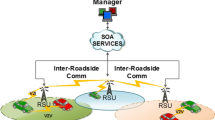Abstract
The use of Information and Communication Technology (ICT) as a copilot for the drivers has a potential to improve traffic safety and efficiency. A key challenge in integrating ICT in vehicular networks is to provide the mechanisms for the delivery of safety messages called beacons. In particular, finding the trade-off between providing sufficient coverage and controlling channel congestion remains the focus in the stipulated amendments for safety message transmissions. In this paper, we handle this trade-off by proposing a Multi-metric Power Control (MPC) approach, which uses application requirements and channel states to determine a transmit power for safety messages. The MPC gives a best-effort approach to satisfy the coverage range requirement of a message as specified by the application. Moreover, the concept distinguishes among message types to provide coverage differentiation. We show that the best-effort approach of providing coverage for different messages can control congestion and as a result improve awareness by minimizing beacon collisions. The performance analysis of MPC using discrete event simulation confirms its practicality.










Similar content being viewed by others
References
CAMP Vehicle Safety Communications Consortium, et al (2005) Vehicle safety communications project: Task 3 final report: identify intelligent vehicle safety applications enabled by DSRC. National Highway Traffic Safety Administration, US Department of Transportation Washington DC
Alam M, Ferreira J, Fonseca J (2016) Intelligent transportation systems: Dependable vehicular communications for improved road safety, springer international publishing
European Commission, E.F.P.f.R., Innovation: Horizon 2020. https://ec.europa.eu/programmes/horizon2020/
Valerie Sathe B, Richard W, Joshua C, Matt S, William T (2013) Expert opinion forecast of connected vehicle technology. Michigan Department of Transportation (MDOT):1– 16
Shah SAA, Ahmed E, Xia F, Karim A, Shiraz M, Noor RM (2016) Adaptive beaconing approaches for vehicular ad hoc networks: A survey. IEEE Syst J PP(99):1–15. doi:10.1109/JSYST.2016.2573680
(2010) IEEE Standard for Wireless Access in Vehicular Environments (WAVE) - Networking Services. IEEE Std 1609.3-2010 (Revision of IEEE Std 1609.3-2007) pp. 1–144 (2010) doi:10.1109/IEEESTD.2010.5680697
Fernandes BF, Alam M, Gomes V, Ferreira J, Oliveira A (2016) Automatic accident detection with multi-modal alert system implementation for its. Veh Commun 3(1):1–11. doi:10.1016/j.vehcom.2015.11.001
Dar K, Bakhouya M, Gaber J, Wack M, Lorenz P (2010) Wireless communication technologies for its applications [topics in automotive networking]. IEEE Commun Mag 48(5):156–162. doi:10.1109/MCOM.2010.5458377
Park Y, Kim H (2013) Collision control of periodic safety messages with strict messaging frequency requirements. IEEE Transactions on Vehicular Technology 62(2):843–852
Rawat DB, Popescu DC, Yan G, Olariu S (2011) Enhancing vanet performance by joint adaptation of transmission power and contention window size. IEEE Transactions on Parallel and Distributed Systems 22 (9):1528–1535
Zhao J, Cao G (2008) Vadd: Vehicle-assisted data delivery in vehicular ad hoc networks. IEEE Trans Veh Technol 57(3):1910–1922
Sahu PK, Wu E, Sahoo J, Gerla M (2013) Bahg: Back-bone-assisted hop greedy routing for vanet’s city environments. IEEE Trans Intell Transp Syst 14(1):199–213
Fonseca A, Vazão T (2013) Applicability of position-based routing for vanet in highways and urban environment. J Netw Comput Appl 36(3):961–973
Uzcategui R, Acosta-Marum G (2009) Wave: a tutorial. IEEE Commun Mag 47(5):126–133
SHAH SAA, SHIRAZ M, NASIR MK, NOOR RBM (2014) Unicast routing protocols for urban vehicular networks: review, taxonomy, and open research issues. Journal of Zhejiang University Science C (Computers & Electronics). doi:10.1631/jzus.C1300332. http://www.zju.edu.cn/jzus/iparticle.php?doi=10.1631/jzus.C1300332
Schmidt RK, Köllmer T, Leinmüller T, Böddeker B, Schäfer G (2009) Degradation of transmission range in vanets caused by interference. PIK-Praxis der Informationsverarbeitung und Kommunikation 32(4):224–234
ETSI T (2010) Intell Transp Syst (ITS):637–2. 102 637–2
Stanica R, Chaput E, Beylot AL (2012) Loss reasons in safety vanets and implications on congestion control. In: Proceedings of the 9th ACM symposium on performance evaluation of wireless ad hoc, sensor, and ubiquitous networks. ACM, pp 1–8
Alam M, Fernandes BF, Silva L, Khan AK, Ferreira J (2015) Implementation and analysis of traffic safety protocols based on etsi standard. In: IEEE Vehicular networking conference VNC, pp 142–150
Torrent-Moreno M, Mittag J, Santi P, Hartenstein H (2009) Vehicle-to-vehicle communication: fair transmit power control for safety-critical information. IEEE Trans Veh Technol 58(7):3684–3703
Kloiber B, Härri J, Strang T, Hrizi F, Bonnet C, Rico-Garcia C, Matzakos P, Krajzewicz D, Bieker L, Blokpoel R (2012) Dice the tx power-improving awareness quality in vanets by random transmit power selection. In: VNC, pp 56–63
Mittag J, Thomas F, Härri J, Hartenstein H (2009) A comparison of single-and multi-hop beaconing in vanets. In: Proceedings of the sixth ACM international workshop on vehicular interNETworking. ACM, pp 69–78
Guan X, Sengupta R, Krishnan H, Bai F (2007) A feedback-based power control algorithm design for vanet. In: 2007 Mobile networking for vehicular environments. IEEE, pp 67– 72
Chen R, Jin WL, Regan A (2010) Broadcasting safety information in vehicular networks: issues and approaches. IEEE Netw 24(1):20–25
Artimy MM, Robertson W, Phillips WJ (2005) Assignment of dynamic transmission range based on estimation of vehicle density. In: Proceedings of the 2nd ACM international workshop on vehicular ad hoc networks. ACM, pp 40–48
Carson JS, et al (2002) Model verification and validation. In: Proceedings of the winter, Simulation conference, 2002, vol 1. IEEE, pp 52–58
Sargent RG (2005) Verification and validation of simulation models. In: Proceedings of the 37th conference on winter simulation. winter simulation conference, pp 130–143
Varga A, et al (2001) The omnet++ discrete event simulation system. In: Proceedings of the european simulation multiconference (ESM?001). p. 65. sn, vol 9
Eckhoff D, Sommer C (2012) A multi-channel ieee 1609.4 and 802.11 p edca model for the veins framework. In: Proceedings of 5th ACM/ICST international conference on simulation tools and techniques for communications, networks and systems: 5th ACM/ICST international workshop on OMNet++.(Desenzano, Italy, 19-23 March, 2012). OMNeT
Acknowledgment
The authors would like to thank the High Impact Research (HIR) University of Malaya, Malaysia for their support.
Author information
Authors and Affiliations
Corresponding author
Rights and permissions
About this article
Cite this article
Ali Shah, S.A., Ahmed, E., Xia, F. et al. Coverage Differentiation Based Adaptive Tx-Power for Congestion and Awareness Control in VANETs. Mobile Netw Appl 23, 1194–1205 (2018). https://doi.org/10.1007/s11036-016-0777-6
Published:
Issue Date:
DOI: https://doi.org/10.1007/s11036-016-0777-6




